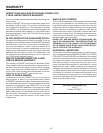
33
TROUBLESHOOTING
Problem
Cause
Solution
Motor stalls (resulting in blown
fuses or tripped circuit breakers).
Frequent opening of fuses or circuit
breakers.
Blade does not run in the approxi-
mate center of the upper wheel.
Band Saw slows down when
cutting.
Blades breaking
Blade dulls too quickly.
Band saw vibrates.
Starting switch not operating.
Voltage too low to permit motor to
reach operating speed.
Fuses or circuit breakers do not
have sufficient capacity
Motor overloaded.
Fuses or circuit breakers do not
have sufficient capacity.
Starting switch not operating (motor
does not reach speed)
Not tracking properly.
Belt too loose.
Cutting too small a radius.
Dull blade.
Overloading motor.
Too much tension on blade.
Kink in blade caused cutting too
small a radius or turning the material
too fast when cutting.
Blade guides set too close to teeth.
Cutting incorrect material.
Too much tension on motor belt.
Have switch replaced.
Request voltage check from the power
company.
Install proper size fuses or circuit break-
ers.
Feed work slower into blade.
Install proper size fuses or circuit break-
ers. Check that wiring will handle load.
Have switch replaced. Blow out sawdust.
Adjust tracking, see Assembly section,
"Tracking the Blade” section.
Adjust belt tension, see Assembly
section, “Mounting the Motor Assembly”.
Stop feeding, and back up the material
slightly, until the band saw speeds up.
Replace blade.
Slow down, trying to cut too fast.
Adjust tension. See Assembly section,
“Adjusting Blade Tension”.
Use correct cutting technique. See
Operation section.
Adjust upper and lower blades guides.
See Assembly section “Installing and
Adjusting the blade”.
Adjust according to “Mounting the Motor
Assembly” section.


















